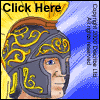
|
The Early Populace By Brian Orr Have a question? Click Here to go to Brian's own Discussion Board!
The Celts were hunters and had the name Selgovae (derived from the Gaelic for hunter ) and also known as Picts or painted people from
the tattoos with which they adorned themselves. Their original dwellings would have been the caves and in
time shelters constructed with stakes in the ground and covered by leafy branches. These progressed to
wattle and daub - sticks and mud, and eventually more substantial buildings of hewn timbers, with gaps
filled by clay and roofed with straw, ferns and turf.
A novel, although quite common feature in the region are the houses built on islands, often man- made by
driving timbers into the bottom of a lake and backfilling. These "crannogs" had hidden, secret, paths to them which would zig-zag beneath the water so only those in the know could safely access them.
A Roman geographer, Claudius Ptolemaeus of the second century placed a large settlement of Caerbantorigum, one of the four main towns of the Selgovae, in the vicinity of the Motte of Urr.
The Roman legions were active in the area in 79 AD and it appears that for three hundred years they occupied the valley of the Urr and probably used the site of the Motte as an encampment. Little is known of the inhabitants after the Romans left Britain in 407 AD and we must assume that there continued to be trade, movement and inter marriage with the Irish Picts just 21 miles across the sea.
You can talk to Brian Orr on his own Discussion Board or you can click here to read more about his extensive research on the Orr family name. |
Thursday, December 26th, 2019
Attention visitors: Tartans.com is back. Please note that this is a snapshot of the site as it existed nearly 20 years ago and you may encounter broken links; we are still combing through the site and correcting those as we find them. Please also note that some sections are currently not functional, primarily the discussion forums/clan chat boards.
|
** HOME - First Time Visitors - Glossary - - Contact Us ** Awards | Bibliography | Clan Calendar | Clan Chat | Clan Finder | History | Famous Scots | Genealogy | Great Hall of the Clans | Links | News and Features | Scots on the Net | Search | Site Map The Gathering of the Clans
Copyright 1995- Tartans.com - All Rights Reserved. |


